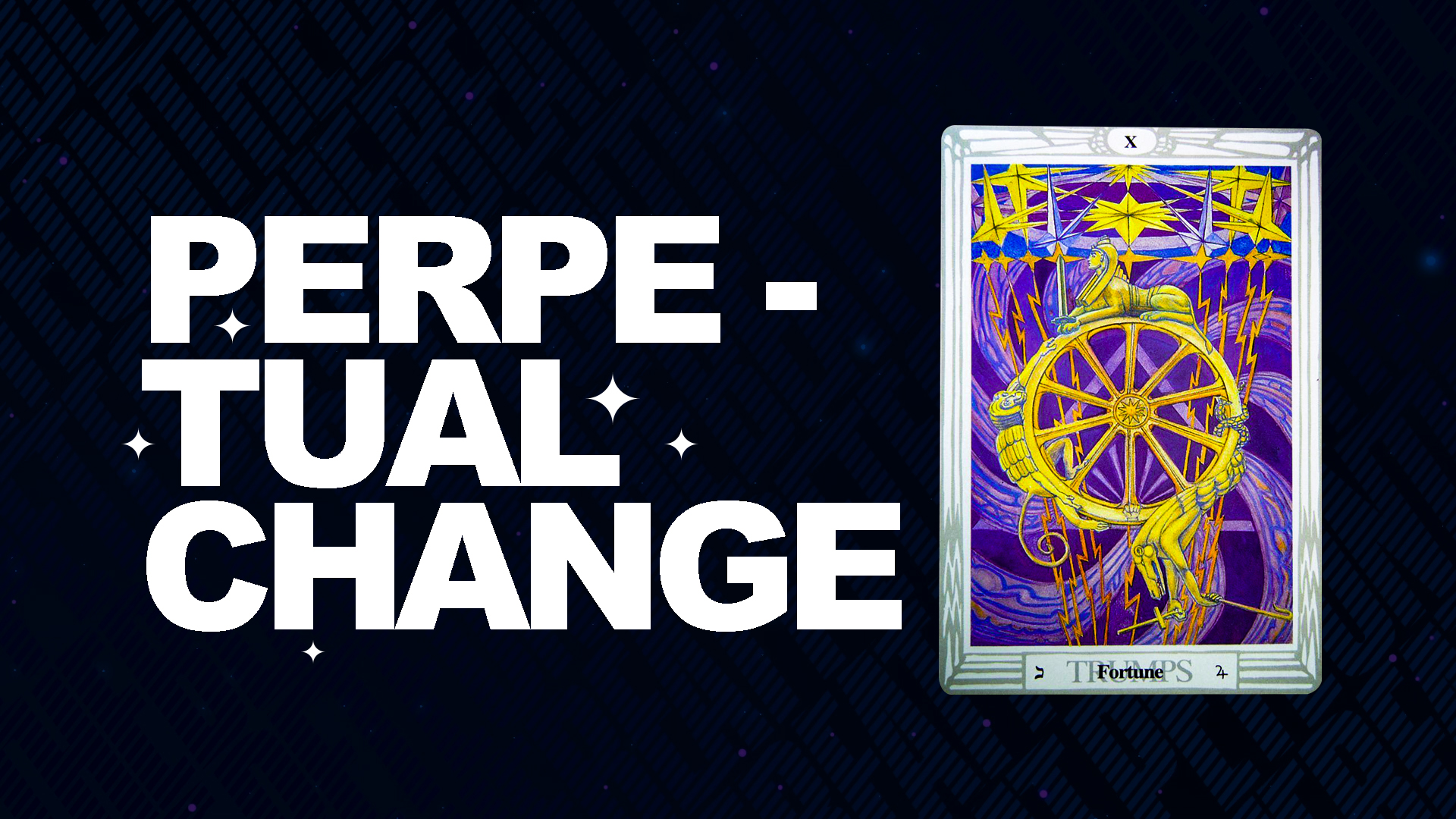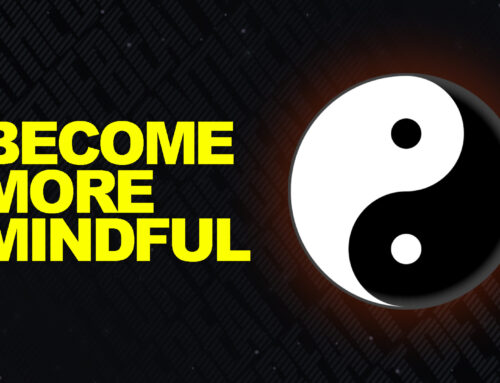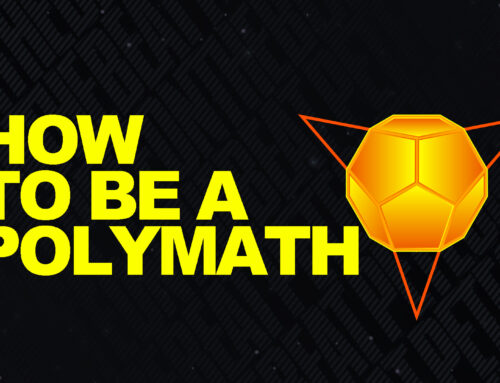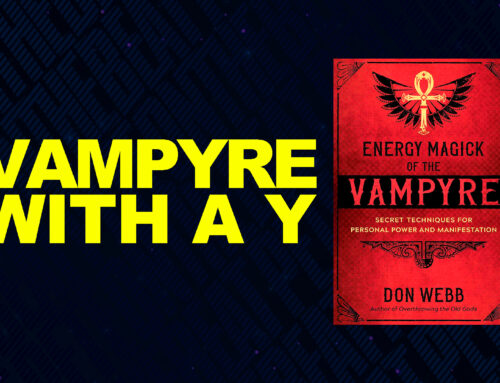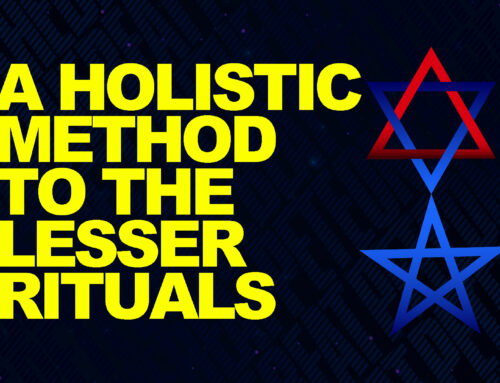Introduction
Loaded with symbolism and colored in Golden Dawn’s ‘Flashing Colors,’ the Thoth Tarot Fortune card represents perpetual change. On its wheel are the Sphinx, the Hermanubis, and Typhon, which are responsible for its motion. They also represent the three alchemical symbols, the three gunas in the Hindu system, and cards: the Magus, the Empress, and the Emperor.
The Sphinx
Temporarily exalted, the Sphinx symbolizes Sulfur and Rajas. It stands for excitement, fierceness, and explosiveness, all expressed by the Emperor. On the contrary, the Sphinx carries a sword, which (is usually) associated with the mind, the intellect, and Mercury (Quicksilver). This sword, according to the book of Thoth, is of the short Roman pattern. The Sphinx comprises the four cherubs in the Thoth Hierophant and the standard Fortune cards. Besides the ‘Elements’ and YHVH, these represent the four magickal virtues: to Know, to Will, to Dare, and to Keep Silent. Traditionally, the Sphinx also represents the union of humanity. This includes the raw animal power and intellect, such as the male (electric) and the female (magnetic) forces in one’s psyche.
The Hermanubis
Lurking on the left is the Hermanubis. It is a Greakoegyptian god conducting the souls of the dead to the underworld. The Hermanubis is a mixture of Hermes (Mercury, Thoth) and Anubis. It operates as a psychopump. This means mediating between the realms of the living and the dead while guiding souls’ transitioning. Part of this is Anubis’s function of weighing one’s heart on a scale. At that stage, the soul is between the dimensions of Isis (life) and Osiris (death). According to ‘The Book of the Dead,’ Thoth also partakes in the ritual. While the Hermanubis attributes to the Magus and thus Mercury (and Sattva), i.e., calmness, balance, clarity, and intelligence, Crowley notes its monkey nature dominates.
Typhon
Staying on the right, Typhon associates with Salt or Tamas, which is death, stagnation, thickness, heaviness, and ignorance. Some sources recognize the salt symbol beside Typhon’s eye. Yet ‘The Book of Thoth’ mentions nothing of it. Typhon holding an inverted Ankh cross symbolizes the opposite of life, fertility, forward motion, and progress. Although it is depicted as some of an alligator, Typhon is (actually) a hellish serpenting giant. As Greek mythology’s one of the deadliest monsters, it attempted to defeat Zeus and obtain supremacy in the Universe.
Thunderbolts
In that fight, however, Zeus (Jupiter) overthrows Typhon with thunderbolts, which extend from the firmament on the Fortune card. Like luck the card represents, these not only destroy but also create. More on that by the end of the video.
The Firmament of Stars
At the top of the Fortune card is the starry firmament, the Goddess Nuit. The four-pointed stars allude to structure and order, YHVH, and materialism, addressed in a moment. The pentagrams represent the individuals in Nuit’s body. This conveys that every man and woman is a star, as remarked in the ‘Book of the Law.’ The pentagrams vary in ray size and color, yet there’s an apparent balance between them. This implies that individual diversity is in harmony with Universal balance.
The Wheel
Considering Sphinx’s direction, the wheel goes counterclockwise. It has ten spokes representing completion, such as Malkuth, the physical world of action, and manifestation. Also, the ten sephiroth and the card’s number. Within the wheel’s center, there’s a ten-rayed star, which kinda mirrors that of the firmament.
Perpetual Change
The Thoth Tarot Fortune card expresses everlasting change. Crowley explains that no matter how powerful, the alchemical states always switch from one to another. It may be viewed that hitting rock bottom in a situation (Salt, Typhon) brings the urge to positive change (Sulphur, the Sphinx) and accomplish a more balanced state (Mercury, the Hermanubis). And apparently, this loosely maps to VITRIOL’s stages addressed in my Rose Cross video.
The Center
It is said there’s an eye in the center of the axle, which is interpreted as Hadit, as Hadit is the center point. Considering the triangle’s positioning in the Thoth Tarot Fortune card, this eye alludes to the Masonic pyramid’s all-seeing Eye of Providence. Considering the whirlings and the later discussed concept of achieving stability and stillness by embracing permanent change, it can be viewed as the eye of the storm in which one finds shelter and balance.
The Fist
The fist at the bottom is another suggestion of the latter examined ‘Kaph’ letter. The six rays behind it allude to the number of the Sun, the Sphere of Tiphereth, and accomplishing the Great Work.
The Triangle
As remarked by stoics and self-help, change is the only sure thing. The Thoth Tarot Fortune card communicates that explicitly. It displays stability and even certainty resulting from the three principles balancing each other, like the sides of the equilateral triangle. This change depicts the cycles of life.
Jupiter
The Fortune card is associated with Jupiter (Jove), who is actually Zeus. While standard decks like the Arthur Waite omit that detail, the Thoth Tarot doesn’t. It emphasizes it through the dominating mixture of King and Queen-scale Jupiter colors. Jupiter rules Sagittarius. Astrology calls it ‘The Greater Benefic’ or ‘The Greater Fortune.’ Also, ‘Lord of Fortune.’ Being Chessed on a lower arc, Venus Netzach is the “Lesser Benefic,” In the planetary royal court, Jupiter is viewed as an advisor and priest. Vedic theology regards it as Brhaspati, the gods’ guru and the celestial realm’s king. Jupiter is considered the most auspicious planet, associated with honesty, purity, truthfulness, and happiness.
The Element of Luck
Jupiter is also considered the planet of knowledge, intelligence, wisdom, and material success. It is worshipped by the Romans as the gods’ king, bringing good Fortune and victory. On the other hand, Jupiter’s extension goes beyond the mere concept of good Fortune. Crowley clarifies it’s the ‘element of luck, the ‘incalculable factor,’ which is neither ‘good’ nor ‘bad’ but in a perpetual change and motion symbolized by the wheel.
The Demiurge
According to the Platonic and Neopythagorean schools of thought, the Demiurge is the material universe’s God. It is also viewed as somewhat delusional about being the supreme divinity due to a lack of understanding of its origins. The word Demiurge is derived from the Latin ‘demiurgos.’ Initially, that meant ‘craftsmanship’ and ‘artisan,’ but eventually transitioned toward ‘creator’ and ‘producer.’ Hence why Plato regarded Jupiter as the creator of the perceptible (tangible) world.
Chessed
This alludes to Chessed, the sphere of Mercy and Majesty being Jupiter’s mystical aspect. Chessed is the highest in the tree, right underneath the three ‘Supernals.’ In that regard, Jupiter’s sephirah wants to keep its place without dissolving into pre-formative states. It holds to the last remnants of form and matter. The reason, some say, is that it’s incapable of understanding Kether’s pure being.
According to Dion Fortune, Chessed is the king who cares for his people, makes laws, and builds cities. It is the ‘Creative Engine‘ of the individual and humanity. An explication of Chessed to consider is in David Shoemaker’s Living Thelema:
“I have consciousness of the oath of my soul, in the many lives I have lived before this one, and I govern my consciousness in the light of this knowledge. I strive, in all things, to live fully as an expression of the Highest Light. Yet, I am more than this…”
Roman and Greek Mythology
Representing primal chaos, Cronos (Saturn), the titan’s leader, and his wife Cybele had children. While their offspring were gods, it was prophecized that one would eventually grow mightier and overthrow Cronos. To prevent that, Cronos devoured his children, but one day, his wife interfered. Also known as Magna Mater (the Great Mother), Cybele took one of their sons. She also gave Cronos a rock, which caused him to throw off some of his children.
Jupiter’s Childhood
Meanwhile, Jupiter, the hidden child, was brought to Earth, remaining hidden until becoming stronger. Next, Jupiter organized his siblings and overthrew Saturn. This brought order and structure to the universe. It also established/divided three stages of manifestation found in the Tree diagram. One is the Supernals, another the abyss, and the third is the seven lower sephiroth, including the material universe. To learn more about that, I suggest my content on the Tree of Life.
Practical Magick
In practical magick, Jupiter Spirits are the ones to call (first) regarding creativity, expansion, and material success. Another used for the last are those of Earth. Some scholars suggest a banishing field to remove limitations and invoke Jupiter to expand. Others claim too much banishing Earth keeps magicians broke. Also, doing the same with the macrocosm might as well banish your luck. Based on personal experience, using an invoking field before Jupiter is superior for growth and expansion. It not only empowers/brings but makes the external and internal world collaborate under that planet’s influence. Let me know if that resonates with you.
Kaph
The Fortune card is one-fifth of the ‘Pillar of Mercy.’ It represents the Hebrew double-letter ‘Kaph’ and the twenty-first path in the tree. Its opposite is the Hanged Man and the twenty-third path in the pillar of severity. It links Chessed (four) with Netzach (seven). This means connecting the highest ideas of mercy and benevolence with the emotions, drives for pleasure, and motivations. West is Kaph’s position in the cube of space. It is the completion of the day and the cycle’s manifestation. It is also where to trace your fifth Jupiter hexagram most of the time.
Intelligence of Conciliation
Paul Foster Case calls the Path of Kaph Intelligence of Conciliation. This can be viewed as a gyroscope with two interlocked wheels spinning in opposite directions. This symbolism represents the mediation of activity between opposing or contrasting forces in motion. The concept conveys a cyclic and everlasting change. It is also called Rewarding Intelligence of Those Who Seek. Besides the Jupiterian order and harmony, this implies assuming the essential-to-success ‘seek, and you’ll find’ state of mind. And this helps harmonize and win over otherwise antagonistic forces.
820
Kaph is twenty, but Kaph Final is 500. It is spelled Kaph and Peh Final, enumerating to 820. It means the palm of the hand. This alludes to the fact that one’s destiny and Fortune can be read through the palm. Also, we turn the wheel of fortune with our palms, navigating through life. Like God spins the universe’s.
Meanings
Some Meanings of the Thoth Tarot Fortune card include:
Generally, good fortune and changes result in opportunities to avail of. The Book of Thoth gives the following two.
“Sped by its energies triune, the wheel of fortune spins: its Axle’s immobile…”
“Follow thy Fortune, careless where it lead thee. The axle moveth not: attain thou that!”
Comment
IMHO, this means making the most out of life by finding stability, certainty, and even peace/stillness by embracing permanent change, reinvention, and renovation. Perhaps one can think of that as achieving those and finding shelter by positioning themselves in the eye of the storm. But that’s just my opinion. Let me know your thoughts on the Fortune card and this video.
- The Power of Mindfulness Meditation - May 1, 2024
- An Autobiography of Trauma Book Review - April 23, 2024
- Reflections on Being a Polymath - April 12, 2024


